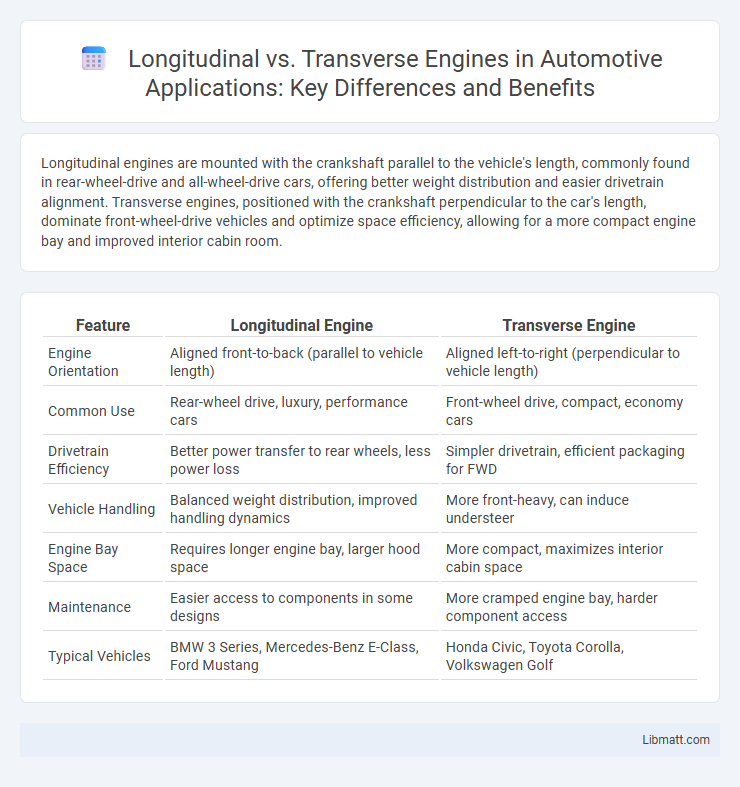Longitudinal engines are mounted with the crankshaft parallel to the vehicle's length, commonly found in rear-wheel-drive and all-wheel-drive cars, offering better weight distribution and easier drivetrain alignment. Transverse engines, positioned with the crankshaft perpendicular to the car's length, dominate front-wheel-drive vehicles and optimize space efficiency, allowing for a more compact engine bay and improved interior cabin room.
Table of Comparison
| Feature | Longitudinal Engine | Transverse Engine |
|---|---|---|
| Engine Orientation | Aligned front-to-back (parallel to vehicle length) | Aligned left-to-right (perpendicular to vehicle length) |
| Common Use | Rear-wheel drive, luxury, performance cars | Front-wheel drive, compact, economy cars |
| Drivetrain Efficiency | Better power transfer to rear wheels, less power loss | Simpler drivetrain, efficient packaging for FWD |
| Vehicle Handling | Balanced weight distribution, improved handling dynamics | More front-heavy, can induce understeer |
| Engine Bay Space | Requires longer engine bay, larger hood space | More compact, maximizes interior cabin space |
| Maintenance | Easier access to components in some designs | More cramped engine bay, harder component access |
| Typical Vehicles | BMW 3 Series, Mercedes-Benz E-Class, Ford Mustang | Honda Civic, Toyota Corolla, Volkswagen Golf |
Introduction to Engine Layouts
Longitudinal engines are mounted parallel to the vehicle's length, offering improved balance and often preferred in rear-wheel-drive and all-wheel-drive configurations. Transverse engines are positioned perpendicular to the vehicle's length, optimizing space for front-wheel-drive cars and enhancing cabin room. Each engine layout influences drivetrain design, weight distribution, and vehicle performance characteristics.
What Is a Longitudinal Engine?
A longitudinal engine is mounted with its crankshaft aligned parallel to the vehicle's length, commonly used in rear-wheel-drive and all-wheel-drive cars. This configuration improves weight distribution and facilitates easier power transfer to the rear wheels. Understanding your vehicle's engine layout helps optimize performance and maintenance.
What Is a Transverse Engine?
A transverse engine is an internal combustion engine mounted so that its crankshaft axis is perpendicular to the vehicle's direction of travel, commonly used in front-wheel-drive cars for compact packaging and efficient space utilization. This configuration allows for a shorter drivetrain, reducing weight and improving fuel economy. In contrast, longitudinal engines align the crankshaft parallel to the vehicle's travel direction, often found in rear-wheel or all-wheel-drive vehicles for enhanced power delivery and balance.
Key Differences: Longitudinal vs Transverse Engines
Longitudinal engines are mounted parallel to the vehicle's length, often found in rear-wheel-drive and all-wheel-drive cars, optimizing power delivery to the rear wheels. Transverse engines are positioned perpendicular to the vehicle's length, commonly used in front-wheel-drive vehicles, allowing for a more compact engine bay and better space efficiency. Understanding Your drivetrain layout helps in choosing a vehicle that suits performance preferences, fuel efficiency, and maintenance needs.
Impact on Vehicle Design and Architecture
Longitudinal engines, mounted parallel to the vehicle's length, enable a more balanced weight distribution ideal for rear-wheel drive and all-wheel drive systems, enhancing handling and performance in sports and luxury cars. Transverse engines, positioned perpendicular to the vehicle's length, optimize space efficiency, allowing for more compact engine bays and increased interior cabin space, which is beneficial in front-wheel-drive vehicles and compact cars. The choice between longitudinal and transverse engine layouts significantly influences vehicle architecture, affecting drivetrain configuration, chassis design, and overall packaging efficiency.
Performance and Handling Considerations
Longitudinal engines typically offer better weight distribution and improved handling balance, making them ideal for rear-wheel-drive and performance-oriented vehicles. Transverse engines save space and reduce vehicle weight, enhancing fuel efficiency but may limit handling precision due to front-heavy weight distribution. Your choice between engine layouts directly impacts driving dynamics and overall vehicle performance.
Maintenance and Repair Factors
Longitudinal engines, aligned front to back, typically offer easier access to components like the transmission and drive shafts, simplifying maintenance and repairs in rear-wheel-drive vehicles. Transverse engines, mounted side-to-side, often lead to more compact engine bays that can restrict accessibility, increasing labor time and complexity during repairs. The choice between longitudinal and transverse layouts impacts serviceability, with longitudinal setups generally favored for simpler upkeep in performance and luxury cars.
Typical Applications and Vehicle Types
Longitudinal engines are primarily used in rear-wheel-drive and all-wheel-drive vehicles, commonly found in luxury sedans, sports cars, and trucks due to their efficient power distribution and balanced weight. Transverse engines dominate front-wheel-drive cars, including compact and midsize vehicles, optimizing space efficiency and reducing manufacturing costs. This configuration suits city cars and family vehicles where interior space and fuel economy are prioritized over performance.
Pros and Cons Comparison Table
Longitudinal engines, mounted parallel to the vehicle's length, typically offer better weight distribution and simpler drivetrain alignment, improving handling in rear-wheel-drive cars but often requiring more space. Transverse engines, positioned perpendicular to the vehicle's length, provide compact packaging that maximizes interior space and is ideal for front-wheel-drive layouts, though they can complicate maintenance and limit performance upgrades. Your choice depends on priorities like handling, space efficiency, or maintenance ease, with a detailed pros and cons comparison table clarifying these trade-offs.
Choosing the Right Engine Layout
Selecting the right engine layout depends on vehicle design and performance goals: longitudinal engines align with rear-wheel-drive setups, offering better weight distribution and handling in sports and luxury cars. Transverse engines optimize space efficiency, favoring front-wheel-drive vehicles and improving cabin room in compact and economy cars. Understanding drivetrain compatibility and packaging constraints is essential for optimal engine placement and vehicle dynamics.
longitudinal vs transverse engine Infographic

 libmatt.com
libmatt.com